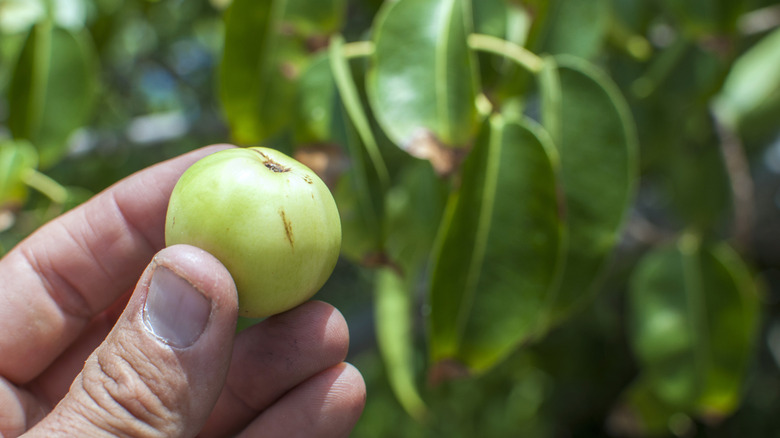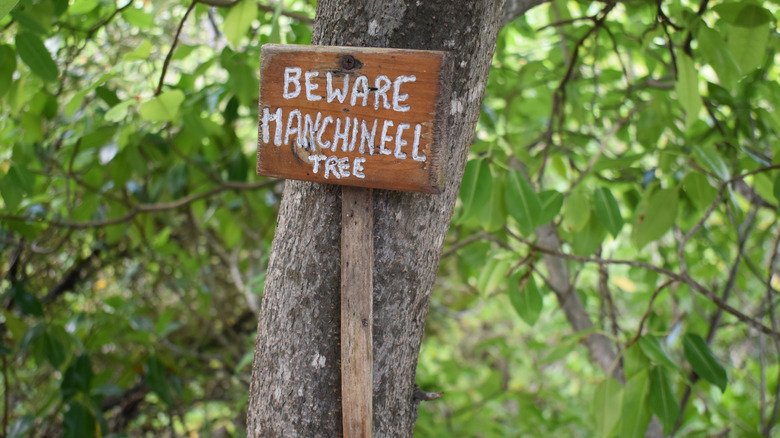Don't Ignore The Warning Signs Around This Deadly Coastal Plant In The Caribbean
With a love of exploration and adventurous experiences comes the risk of hazards and risky predicaments. Among the most breathtaking destinations in the world are dangerous islands, teeming with threatening animals or toxic flora. To be more specific, the Manchineel Tree is a deadly coastal plant that entered the Guinness Book of Records as the world's most dangerous tree. The plant grows along the Caribbean coast of both Central and South America, including the West Indies, Florida's Everglades National Park, and the Florida Keys. The trees reach up to 50 feet in height and thrive in brackish waters, germinating along beaches and flourishing in groups, nestled among mangroves. Seemingly inoffensive due to its small, green apple-like appearance, the fruit and its sap are extremely harmful.
Every part of this shrub can be toxic — from its wood and fruit to its leaves and milky sap. The most common side effects caused by the plant are sore throat, stomach pain, and diarrhea, with a 1% possibility of slow heart rate and low blood pressure. They carry phorbol and other toxins that cause inflammation, dermatitis, and burning blisters if touched. In some cases, scorching smoke from the bark can induce irritation and potential blindness, caused by the toxic smoke. If you happen to be around, it's pivotal to keep your distance and observe the warning signs, since both rainwater and leaf runoff can provoke eye and skin infections, even without hands-on contact. Eating the fruit overexcites the nervous system, deranging the normal nerve signals and leading to abdominal bleeding. It's important to recognize its features, so pay attention to shiny, oval-shaped leaves, grey or reddish bark with creases, small yellow-hued flowers growing on the branches, and last but not least, the apple-resembling fruit is either green or yellow with a touch of orange, and measures one to two inches in diameter.
How the fruit was discovered and how to treat exposure
The first recorded encounter with this deadly fruit was by the European explorer Peter Martyr D'Anghiera, who wrote in the late 15th and early 16th centuries about reports from Spanish explorers, including Christopher Columbus' men. He mentioned there was an enigmatic tree that had left his companions blind and with burns on the skin. This sweet-smelling fruit was nicknamed "Manzanilla de la Muerte," which is Spanish for "little apple of death," and is arguably credited to Columbus. Despite its noxious nature, the tree is still used in some areas to build furniture and Native people utilized its sap to tip arrows for hunting.
It is believed that Spanish explorer Juan Ponce de Leon was killed in Florida in 1521 by the Calusa people using a poison-soaked arrow. Historians and scientists have reason to believe that many shipwreck survivors suffered painful injuries from eating the produce, as did cardiologist Nicola Strickland after unknowingly biting the forbidden fruit on the Caribbean island of Tobago in 2000. As mentioned in Atlas Obscura, the website Mother Nature Network published her statement: "Moments later we noticed a strange peppery feeling in our mouths, which gradually progressed to a burning, tearing sensation and tightness of the throat. The symptoms worsened over a couple of hours until we could barely swallow solid food because of the excruciating pain and the feeling of a huge obstructing pharyngeal lump."
When coming into contact with the tree, you should seek medical assistance immediately. Wash your skin properly — if your hands are not infected — apply hydrocortisone cream or use cold compresses, rinse eyes carefully, and take an antihistamine if your symptoms get worse, as published by the digital health magazine WebMD. It's best to have your first-aid checklist ready for your next island vacation.

